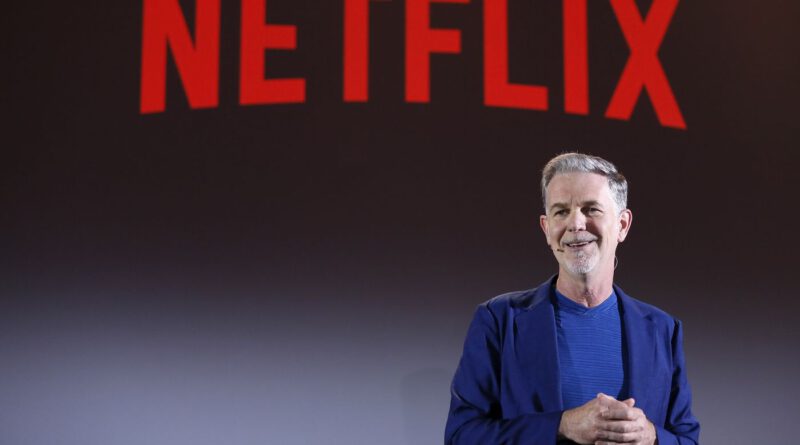Netflix adds 15 million subscribers as people stream more than ever, but warns about tough road ahead
Netflix is one of the rare companies benefiting from the global pandemic, which has kept billions of people at home with nothing to do but stream. But the question is how long can it last?
Although much of Netflix’s recent boom didn’t start until mid-March, when more people were forced to stay home to help curb the spread of the novel coronavirus, a series of popular, original shows and movies helped Netflix boost subscribers in its first quarter. Netflix added 15.8 million subscribers, more than double the 7.2 million that were expected — a growth of more than 22 percent year over year. Netflix now has 182 million subscribers worldwide. The company also saw quarterly revenue of $5.77 billion versus the $5.76 billion estimated.
Still, Netflix’s opening letter to shareholders isn’t all good. The letter notes that “some of the lock-down growth will turn out to be pull-forward from the multi-year organic growth trend, resulting in slower growth after the knockdown is lifted country-by-country.” The letter adds that executives expect “viewing to decline and membership growth to decelerate as home confinement ends, which we hope is soon.”“WE’RE SEEING TEMPORARILY HIGHER VIEWING AND INCREASED MEMBERSHIP GROWTH”
“At Netflix, we’re acutely aware that we are fortunate to have a service that is even more meaningful to people confined at home, and which we can operate remotely with minimal disruption in the short to medium term,” the letter reads. “Like other home entertainment services, we’re seeing temporarily higher viewing and increased membership growth. In our case, this is offset by a sharply stronger US dollar, depressing our international revenue, resulting in revenue-as-forecast.” Netflix is taking extra precautions right now in an uncertain time, including “temporarily reduced the number of product innovations we try.”
The big question is about content, and Netflix is more than hopeful that it will be able to continue releasing shows.
“While our productions are largely paused around the world, we benefit from a large pipeline of content that was either complete and ready for launch or in post-production when filming stopped,” the letter reads. “So, while we’re certainly impacted by the global production pause, we expect to continue to be able to provide a terrific variety of new titles throughout 2020 and 2021.”
A consistent stream of new originals gives Netflix a leg up over other streaming services. One of the biggest advantages Netflix has over its competitors ties directly into its release strategy; because full seasons of shows are available at once, Netflix has to have full seasons ready to go. That means TV shows it has in the pipeline for May, June, and July are fully complete seasons, so Netflix doesn’t have to worry about filming more episodes like networks do.NETFLIX HAS ENOUGH ORIGINAL CONTENT IN THE PIPELINE TO SURVIVE THE NEXT FEW MONTHS
Chief content officer Ted Sarandos previously acknowledged that Netflix has enough original content in the pipeline to survive the next few months, but like other companies, production stoppage will affect Netflix. Forward-looking statements from CEO Reed Hastings reiterate what many other entertainment companies are saying: it’s going to be a long, tough road ahead. While Netflix prepares for the long haul, analysts see Netflix as being more prepared to weather the storm than other competitors.
“Obviously, everyone is in the original content game for the next nine to 12 months,” Steve Nason, research director at Parks Associates, told The Verge. “But they’re going to be fine. They have a big original library compared to competitors.”
Some analysts see Netflix’s dominance as a streamer as a double-edged sword. The company is still mostly seeing additional gains domestically, but it’s slowed down considerably. Last quarter, Netflix only added 550,000 subscribers domestically, but it saw an additional 8.4 million subscribers globally. The company has leaned more heavily on its international growth in recent earnings reports and SEC filings, pivoting some of its focus to developing those international territories.“WHEN YOU’RE NUMBER ONE, IT’S ALWAYS DIFFICULT TO GROW AS FAST AS YOUR COMPETITORS OR WHOEVER’S TRAILING YOU”
Other analysts, like Nason, see it as a natural progression for the company. Netflix is a “foundational service,” according to Nason. It’s already in the majority of people’s homes who are going to pay for Netflix. Plus, people aren’t likely to give it up when it comes time to cut down on streaming services. Those who don’t have Netflix now, when it’s arguably the best time for streamers to get people’s attention, likely won’t going forward, Netflix’s letter argues.
“Intuitively, the person who didn’t join Netflix during the entire confinement is not likely to join soon after the confinement,” the letter reads.
It’s hard to grow from that spot domestically, Nason added, but said because of Netflix’s aforementioned advantages, Netflix’s subscriber base in the United States could continue growing over the next several months.
“When you’re number one, it’s always difficult to grow as fast as your competitors or whoever’s trailing you,” Nason said. “Ever since they hit the 60 million subscribers mark about three or four quarters ago, they’ve seen decelerating growth. Most of the growth they’re seeing is international where they’re still growing much, much faster.”
Netflix is far ahead of its competitors, according to HarrisX, a market research and consulting company that specializes in online polling and data analytics. Netflix took up 72 percent of streaming time in homes, according to a new research report from MoffettNathanson in partnership with HarrisX, “while overall streaming penetration reached 74 percent, implying very healthy subscriber growth in the quarter.”“PEOPLE ARE CONSUMING, NOT JUST NETFLIX, BUT ALL KINDS OF VIDEO CONTENT AT AN UNPRECEDENTED LEVEL”
That could help explain Netflix’s skyrocketing performance on Wall Street. The company’s boasting an impressive valuation as stocks reach an all-time high, rising 30 percent year over year. Unlike Disney Plus, which has an impressive catalog of older films and TV shows, Netflix and Hulu continue to best serve people looking to watch something on a daily basis, according to MoffettNathanson. Netflix also believes that its ongoing curation of new series on top of its licensed library will help weather the storm compared to its competitors.
“Our content competitors and suppliers will be impacted about as much as we are, in terms of new titles,” the letter to shareholders reads. “Since we have a large library with thousands of titles for viewing and very strong recommendations, our member satisfaction may be less impacted than our peers’ by a shortage of new content, but it will take time to tell.”
The longer that Netflix has a captive audience because of the coronavirus pandemic, and as long as Netflix can continue serving new content, the company will continue to have a major advantage.
“People are consuming, not just Netflix, but all kinds of video content at an unprecedented level,” Nason said. “It’s probably going to get a little more challenging as new entrants enter the market. Peacock launched, and HBO Max is a huge service launching next month. Even Quibi to a much much lesser extent. Disney Plus certainly has some type of impact. Even then, none have the original lineup that Netflix does right now.”
News Source: THE VERGE
Featured image for representation.



